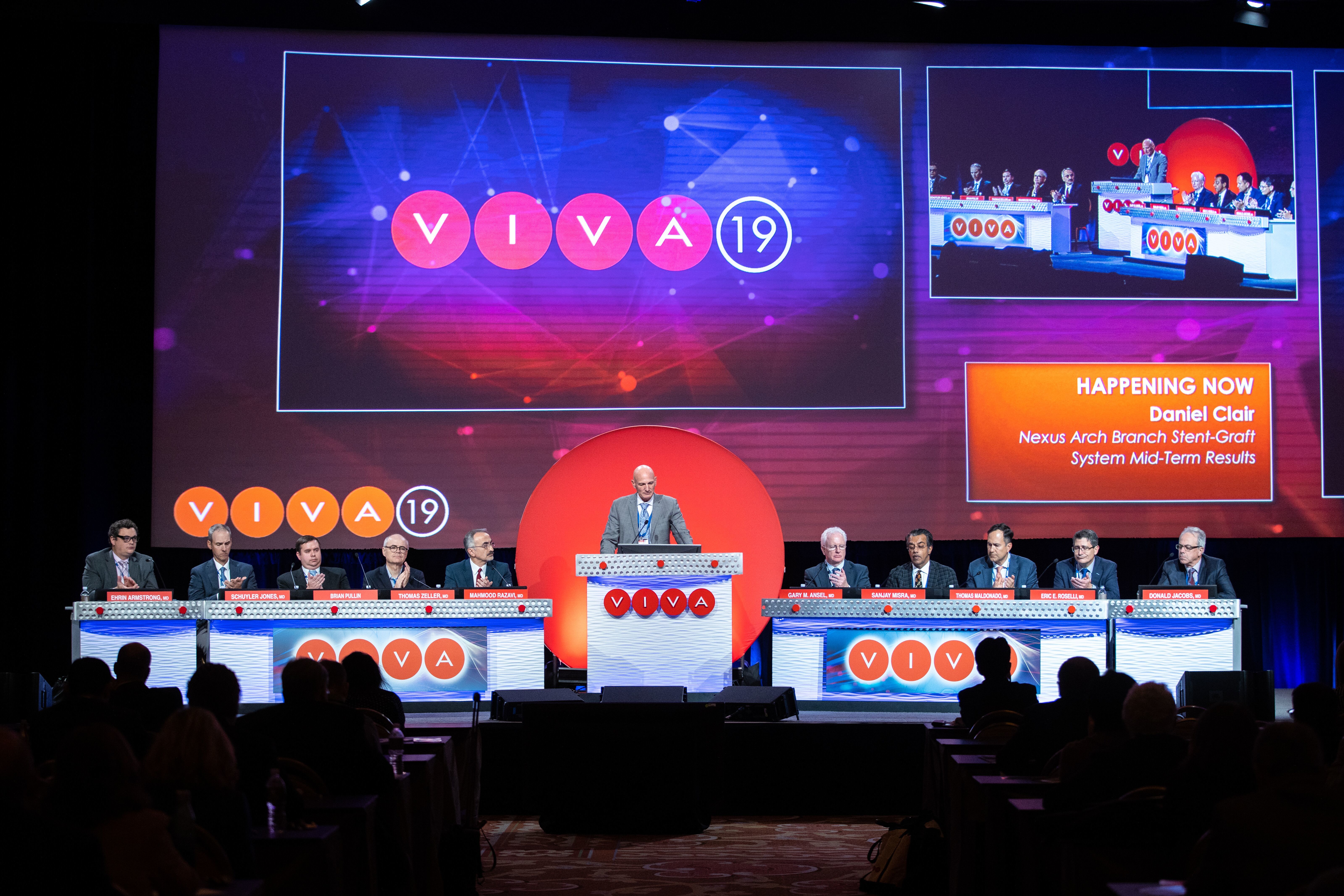
November 5, 2019
Five More Late-Breaking Clinical Trials Announced at VIVA19
Five More Late-Breaking Clinical Trials Announced at VIVA19
LAS VEGAS, 11/5/19 -- VIVA Physicians, a not-for-profit organization dedicated to advancing the field of vascular medicine and intervention through education and research, announces the second round of 21 highly anticipated late-breaking clinical trial results at VIVA19 hosted at Wynn Las Vegas.
Below are highlights of this afternoon’s five late-breaking clinical trial presentations.
Full Cohort 24-Month Safety and Efficacy Results of the VMI-CFA Trial
Presenter: Koen Deloose, MD
Although common femoral artery (CFA) endarterectomy is still considered the gold standard treatment for patients with CFA stenosis, 12-month follow-up results of the VMI-CFA study showed that endovascular repair is a safe and effective alternative. The repuncturable Supera vascular mimetic peripheral stent system (Abbott Vascular) can manage bulky, heavily calcified CFA disease due to its extreme crush resistance.
The multicenter, prospective, single-arm VMI-CFA trial evaluated the outcomes of treatment of symptomatic (Rutherford class 2–4) CFA stenotic or occlusive lesions with the Supera stent in 100 patients. All patients had de novo lesions (> 50% stenosis). The primary efficacy endpoint was core lab–assessed duplex ultrasound primary patency at 12 months, and the primary safety endpoint was the absence of periprocedural adverse events up to 30 days postprocedure. The cumulative primary patency rates up to 365 and 395 days were 95.2% and 92.8%, respectively. The cumulative freedom from target lesion revascularization (TLR) rate was 97.8%. No procedure- or device-related adverse events were reported.
To investigate the longer-term durability of the endovascular approach, the 24-month VMI-CFA study results were prospectively analyzed. No new loss of primary patency or TLR was reported, resulting in a cumulative primary patency rate of 92.8% and a freedom from TLR rate of 97.8% at 730 days. The cumulative survival rate was 85.5%. The tremendous shift from Rutherford class 3–4 toward Rutherford class 0–1 was sustained at 2 years.
These 2-year data confirm that CFA disease can be treated endovascularly with the Supera stent with great outcomes and a very good safety profile. A head-to-head randomized controlled trial of Supera vs endarterectomy (SUPERSURG RCT) will be launched in 2020 to further clarify the CFA treatment discussion.
Nexus Arch Branch Stent Graft System—Mid-Term Results
Presenter: Daniel Clair, MD
The Nexus aortic arch stent graft is a CE Mark–approved, off-the-shelf system for endovascular treatment of pathologies extending or involving the aortic arch. Two-year results from a prospective multicenter premarket study including 25 patients (mean age, 73 years) treated with Nexus are presented.
Nexus is a modular stent graft introduced via a 20-F delivery system with double flushing ports, which allows efficient de-airing. The main module is deployed over an axillofemoral guidewire to extend from the brachiocephalic trunk to the descending aorta and is combined with a precurved ascending module that conforms to the ascending aorta.
All patients had aneurysm size > 55 mm and were considered high risk for conventional open arch surgery by a multidisciplinary team. Indications for treatment were aneurysm (15 [60%] patients) or dissection (10 [40%] patients), including seven patients previously treated surgically for type A dissection. Thirteen (52%) patients had prior thoracic aortic surgery. Supra-aortic bypasses were performed prior to Nexus implantation.
Technical success was achieved for all intended Nexus introductions and deployments (100%). At 30 days, two (8%) patients died from cardiac causes and two (8%) patients showed nondisabling stroke, which resolved completely within 30 days. During a mean follow-up of 25 months, there was one additional procedure-related mortality from stroke, and one patient was converted to open surgery following retrograde type A dissection. During follow-up, aneurysm size decreased or remained stable in 96% of the patients, with no aneurysm-related deaths.
The Nexus system is the first CE Mark–approved branched stent graft for the aortic arch. Design features that assist in minimizing manipulations may explain the high technical success, low rate of neurologic complications, and durability, allowing safe endovascular repair.
Mid-term results at a mean 25-month follow-up are stable without any material failure or stent graft issues. However, more experience and longer follow-up are necessary to confirm these promising mid-term results.
Revolution Rotational Atherectomy System IDE Experience
Presenter: Jeff Carr, MD
The Revolution rotational atherectomy system (Rex Medical) incorporates continuous aspiration and has a dual indication for atherectomy and thrombectomy. The device is intended for atherectomy of the peripheral vasculature in patients with obstructive atherosclerotic disease both above and below the knee. No capital equipment is required. The spheroid-shaped burr rotates at 140,000 rpm to ablate plaque, which is aspirated into the catheter.
The primary objective of the REVEAL trial was to evaluate the safety and effectiveness of the Revolution peripheral atherectomy system in patients with symptomatic infrainguinal lower extremity arterial obstructive disease. One hundred twenty-one patients were enrolled at 17 U.S. sites. Patients with Rutherford category 2 to 5 disease and lesions with ≥ 70% stenosis were eligible. The primary safety endpoint was a composite of 30-day major adverse events, including all-cause mortality, clinically driven target lesion revascularization, amputation, vessel perforation, and embolization. The primary effectiveness endpoint was technical success, defined by core laboratory–assessed ≤ 50% diameter stenosis after treatment prior to adjunctive therapy.
The 30-day primary safety and effectiveness endpoints were met, with freedom from 30-day major adverse events in 110 of 113 (97.3%) intention-to-treat patients at 30 days (both distal embolizations were clinical events committee–adjudicated as nondevice-related) and technical success in 111 of 123 (90.2%) target lesions. Excluding lesions that were treated with a burr not appropriately sized for the vessel diameter from the data set in which the postatherectomy stenosis was > 50%, the technical success rate was 95.7% (111 of 116 patients) (nonimputed). The procedural success rate was 93.7% (119 of 127 patients). The 6-month outcomes were also favorable.
The REVEAL study findings confirm a favorable safety and effectiveness profile through 6 months for the Revolution peripheral atherectomy system.
1-Year Results From the MIMICS-3D Registry: Investigating the BioMimics 3D Stent
Presenter: Michael Lichtenberg, MD
BioMimics 3D (Veryan Medical) is a nitinol stent designed to provide optimal radial support, flexibility, durability, visualization, and delivery accuracy for femoropopliteal intervention. The addition of a unique three-dimensional (3D) helical centerline provides the advantages of biomechanical stability and swirling blood flow.
BioMimics 3D was evaluated in the MIMICS randomized controlled trial (RCT) in which patients received either a BioMimics 3D helical stent or a straight stent control. The Kaplan-Meier estimate of freedom from clinically driven target lesion revascularization (CD-TLR) at 1 year for those treated with BioMimics 3D was 91%. A second study, MIMICS-2, conducted in the United States, Japan, and Europe, met 30-day safety and 12-month primary patency endpoints, and the 1-year Kaplan-Meier estimate of freedom from CD-TLR was 88%.
A European registry (MIMICS-3D) is now investigating outcomes in patients with longer, more complex lesions; complementary use with drug-coated balloons occurred in 50% of procedures. MIMICS-3D enrolled 507 patients at 23 sites. The primary safety end-point is a composite of major adverse events (MAEs) or CD-TLR through 30 days. The primary outcome measure for effectiveness is freedom from CD-TLR through 12 months. An independent clinical events committee adjudicated MAEs.
Technical success of the BioMimics 3D procedure as assessed by the operator was 98%. The percentage of patients with improvement of ≥ 1 Rutherford category at 1 year compared to baseline was 87% (322/370); 12-month freedom from CD-TLR was 89%, which aligns with results from the MIMICS RCT and MIMICS-2 studies, despite treatment of more complex disease. For patients treated with or without a drug-coated balloon and BioMimics 3D, there was no difference in CD-TLR (89.5% and 88.5%, respectively; P > .88).
These three studies confirm that imparting a helical shape onto the vessel with BioMimics 3D and imparting swirling flow improves outcomes and suggest that swirling flow is nature’s alternative to drug elution.
Treatment of BTK Disease With a Novel Device: Update on the DEEPER OUS Trial Presenter: Thomas Zeller, MD, PhD
Peripheral artery disease (PAD) of the infrapopliteal arteries is associated with decreased quality of life and increased morbidity and mortality. Several factors contribute to high restenosis rates in the infrapopliteal arteries, and new devices continue to be developed to address these challenges.
The purpose of the DEEPER OUS study is to evaluate the safety and efficacy of a novel device, the Temporary Spur stent system (Reflow Medical, Inc.), in conjunction with a commercially available drug-coated balloon. An angiographic substudy examining recoil will be conducted on the first 10 patients from each site.
This trial is a prospective, multicenter, nonrandomized, single-arm study. Trial enrollment began in July 2019 and is presently ongoing, with anticipated completion in 2020. The study will consist of 100 patients in New Zealand, Germany, and Switzerland.
Acute technical and procedural success are presented for patients enrolled through October. Ultrasound and clinical data from the first enrolled patients are presented.
The Temporary Spur stent system appears to be a feasible and safe method for the treatment of disease in the infrapopliteal arteries. Examination of patency rates and long-term safety data is ongoing in the DEEPER OUS trial.
About VIVA Physicians
VIVA Physicians, a not-for-profit organization dedicated to advancing the field of vascular medicine and intervention through education and research, strives to be the premier educator in the field. Our team of specialists in vascular medicine, interventional cardiology, interventional radiology, and vascular surgery is driven by the passion to advance the field and improve patient outcomes. Educational events presented by VIVA Physicians have a distinct spirit of collegiality attained by synergizing collective talents to promote awareness and innovative therapeutic options for vascular disease worldwide. To learn more about VIVA Physicians, visit www.vivaphysicians.org.
SOURCE VIVA Physicians
For further information: press@vivaphysicians.org
